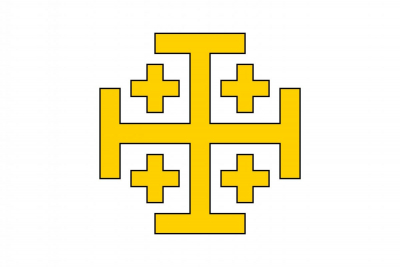The siege of Sidon was an event in the aftermath of the First Crusade. The coastal city of Sidon was captured by the forces of Baldwin I of Jerusalem and Sigurd I of Norway, with assistance from the Ordelafo Faliero, Doge of Venice.
The Kingdom of Jerusalem (Latin: Regnum Hierosolymitanum; Old French: Roiaume de Jherusalem), officially known as the Latin Kingdom of Jerusalem or the Frankish Kingdom of Palestine, was a Crusader state established in the Southern Levant by Godfrey of Bouillon in 1099 after the First Crusade. The kingdom lasted nearly two hundred years, from 1099 until 1291 when its last remaining possession, Acre, was destroyed by the Mamluks. Its history is divided into two distinct periods.
The First Kingdom of Jerusalem lasted from 1099 to 1187 before being almost entirely overrun by Saladin. Following the Third Crusade, the kingdom was re-established in Acre in 1192, and lasted until the city's destruction in 1291. This second kingdom is sometimes called the Second Kingdom of Jerusalem or the Kingdom of Acre, after its new capital. Acre remained the capital, except for the two decades which followed Frederick II of Hohenstaufen regaining the city of Jerusalem from the Ayyubids during the Sixth Crusade through diplomacy.
The vast majority of the crusaders who established and settled the Kingdom of Jerusalem were from the Kingdom of France, as were the knights and soldiers who made up the bulk of the steady flow of reinforcements throughout the two-hundred-year span of its existence. Its rulers and elite were therefore of French origin. The French Crusaders also brought the French language to the Levant, thus making Old French the lingua franca of the Crusader states.Local Muslims and Christians made up the majority of the population in the countryside, but European—mainly French, Italian and Catalan—colonists also settled in the villages. Sugar refining, based on local sugarcane plantations, developed into an important industry.

 English
English  español
español  français
français  português
português  русский
русский  العربية
العربية  简体中文
简体中文 
